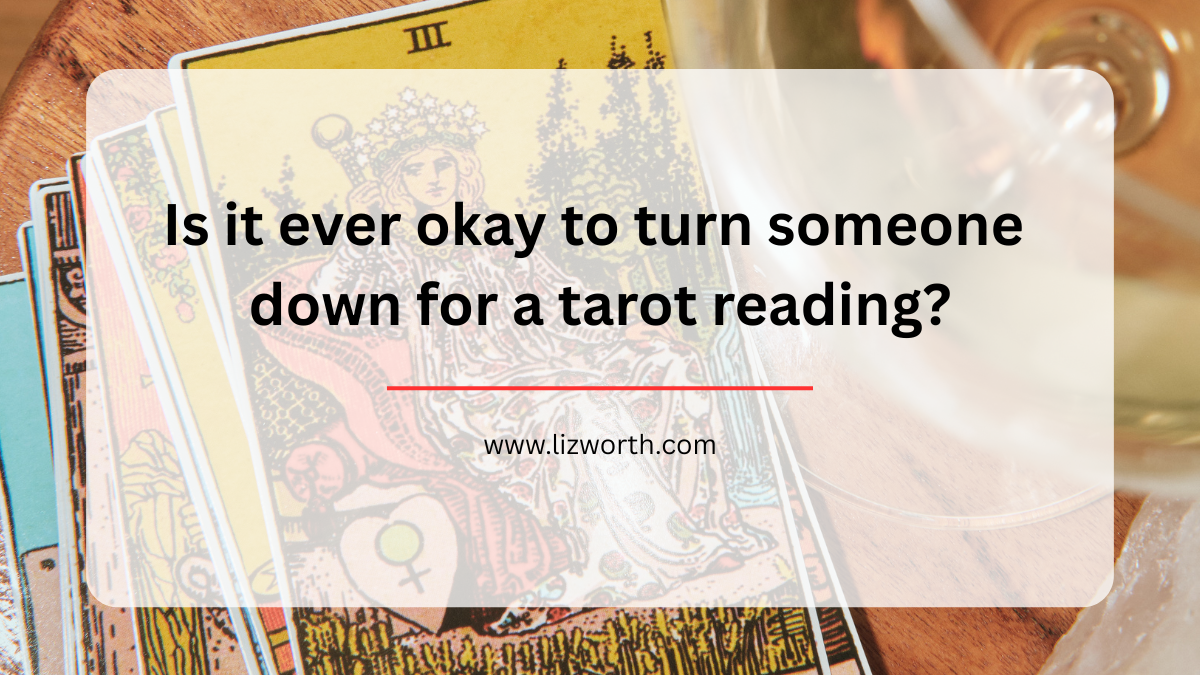Is it ever okay to turn someone down for a tarot reading?

It's important to set boundaries as a tarot reader. But when does it border on being too picky with the clients you take on?
Red flags are a hot topic these days.
And there a lot of good reasons for that. I bet we all have at least a handful of regretful or painful experiences that, in hindsight, could have been avoided if only we’d paid attention to the signs.
In service-based work like tarot reading, coaching, or other one-on-one offerings, there’s a lot of advice out there on how to attract your “ideal client.”
Because no one wants to sit down to read tarot for someone who turns out to be a less-than-stellar client, right?
Afterall, you don’t go into business for yourself just to feel like you’re being bossed around by a bunch of pain-in-the-butt customers.
Before I go further, I will say there’s a big difference between choosing “ideal clients” versus feeling like someone is a potential threat to your safety. Obviously, if you feel unsafe, that’s a red flag to watch for.
Outside of that, there are a lot of other recommendations out there about how spot client red flags from the start, such as:
- Getting an email from a new client that just seems to set something off. Maybe the way they’ve articulated their questions doesn’t make sense, or they’re asking for information that’s easily found on your website;
- Trusting your gut if a client just doesn’t seem right for whatever reason – before you’ve even met them;
- Declining to work with a client altogether because they’re asking for an exception to your payment options or schedule;
- Turning down clients because they want to get a reading about things you’re not interested in exploring.
But we always have to be careful about how and when we follow this advice – if at all. Sometimes the impression I get from these types of tips borders on being impatient, picky and closed off.
Not everyone, or everything, is a threat to your time or energy.
When we’re determining our boundaries and red flags with clients, I think it’s important that we’re not shutting people out prematurely.
Because what I’ve learned in my tarot practice is that you can’t always judge a person by how they write an email.
Or by how well they can navigate your website.
Or by what they might ask about how you work and whether there’s any flexibility to your hours, payment options, or other processes you’ve set up.
Sometimes, red flags are not red flags at all. They are simple opportunities for old fashioned customer service, patience, or acceptance.
There have been several times I’ve been wary about a client for whatever reason, but when I’ve checked in a bit deeper with myself about it, I’ve found that tiredness or unrelated stress is masking itself as anxiety.
If I’d given in to every feeling of doubt about a client, I would have missed out the chance to work with some really great people.
It is okay to say no to a request. It is okay to set boundaries and expectations by informing clients about how you work and what kinds of outcomes they can expect from you.
And it is okay to trust that your clients know what they want, and that there’s good reason they’re choosing to work with you. Give yourself an opportunity to find out why.
Yes, there will be times when readings go sideways. There will be times when a client is the totally wrong fit. But you won’t always know until you’re both sitting down to work together – and that’s something we need to accept as tarot readers.
One thing I think practitioners miss out on when they are too eager to turn away clients is the opportunity to grow. Exploring a question through tarot you’ve never tried before, challenging yourself to find middle ground with a resistant or difficult querent.
Or taking on unusual or unexpected questions. Or working through miscommunications with clients to find common ground.
And I think that’s sometimes missing when in discussions about finding our “ideal” clients.
Yes, you want (and deserve) a tarot client who is open, respectful, and willing to listen – those should be a given.
And you want to make sure, of course, that clients understand what tarot can and can’t do. If someone is there expecting something completely different than what you offer, then that could pose an issue.
But reading tarot is also about recognizing that there are a lot of ways tarot can help people, and it doesn’t always have to feel easy.
It’s good to stretch yourself sometimes, as long as it’s an appropriate, healthy challenge.
I think we lose patience with each too easily these days, assuming that someone or something is wrong before we’ve even given it a chance.
We can have our boundaries and dealbreakers, but balance those with an open, willing mindset. Sometimes clients are our teachers, and we can learn so much about compassion, empathy, and patience when we decide to say yes.
Until next time,
Liz
Categories: : professional tarot readings, tarot business, tarot ethics
 Liz Worth
Liz Worth 